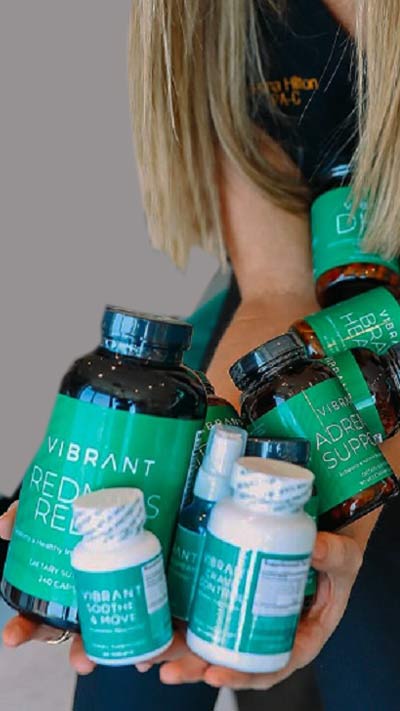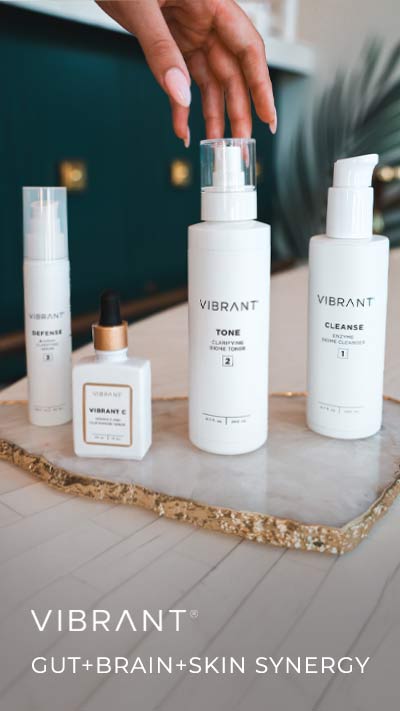Few things make a teenager’s life more miserable than acne. However, many adults also experience this skin condition.
Acne cannot be permanently cured, but modern medicine can alleviate its symptoms. Additionally, there are many preventive measures that you can take to remove blemishes and minimize the risk of permanent acne scarring.
This article presents ten types of acne and explains how to recognize and treat each type based on the root cause.
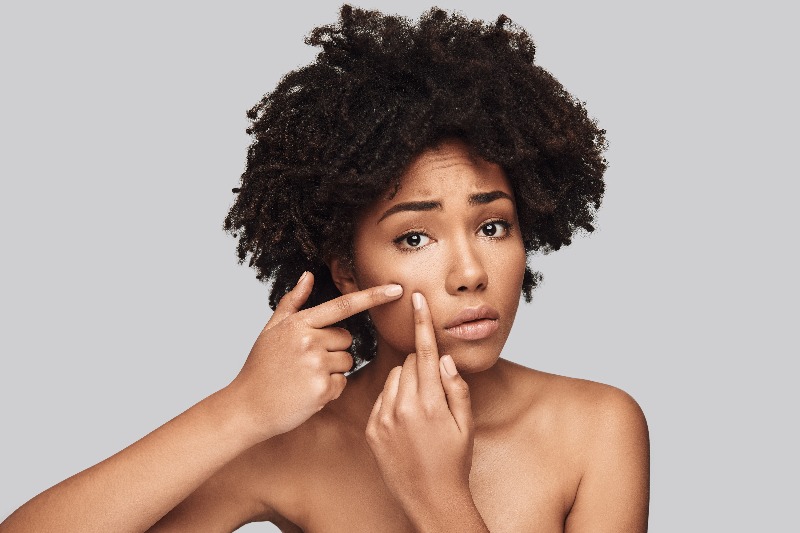
10 Types of Acne
Acne differ in terms of severity, the underlying cause, and how they form. The basic distinction is between non-inflammatory and inflammatory acne.
Non-inflammatory acne don’t cause swelling and are easier to treat with over-the-counter (OTC) medications. Inflammatory acne is a form of skin inflammation that requires a dermatologist’s evaluation and prescription drugs.
Note: Read about types of acne scars, how they form, and how to treat them.
Non-Inflammatory Acne
Non-inflammatory acne, also called comedones, can be whiteheads and blackheads. Comedonal acne appear as small, flesh-colored pimples that do not cause any swelling, redness, or irritation.
This mild type of acne forms due to excess sebum (oil) in hair follicles. When dirt, sweat, and dead skin cells clog the pores, the skin’s surface breaks out in small bumps.
1. Blackheads
Blackheads (open comedones) are small bumps under the skin with a black top on the surface of the skin. They do not cause swelling or inflammation and are considered mild acne.
Blackheads form when dead skin cells and sebum mix and clog a pore, but its top remains open. The air enters the pore and oxidizes its content, making the acne look dark.
Excess sebum production is typical of hormonal fluctuations (e.g., during the teenage years or menopause). Certain medications may also cause skin irritation and more frequent breakouts.
Note: Learn what is the best acne treatment for teens to help you keep this condition under control.
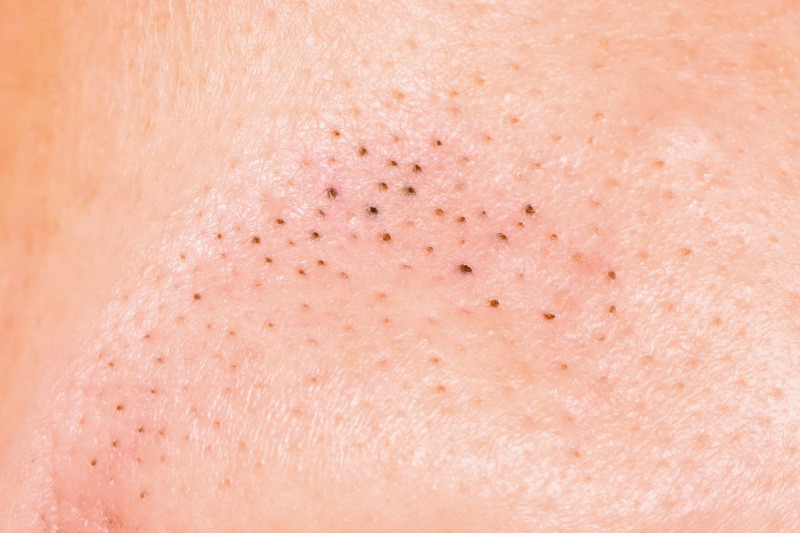
How to treat blackheads?
Look for the non-comedogenic ingredients in skincare products. These products are typically lightweight, oil-free, and able to neutralize surface bacteria. A good example would be ZO Skin Health Acne Control.
Stay away from comedogenic ingredients, which are heavy, oily, and pore-clogging. They can cause excess sebum production and lead to more blackheads.
Never squeeze blackheads. Treat them with OTC skincare products that contain salicylic acid or benzoyl peroxide. If blackheads do not go away after a few weeks, a doctor may prescribe topical retinoids.
Note: Learn how to get rid of oily skin and minimize future breakouts.
2. Whiteheads
Whiteheads (closed comedones) are small bumps under the skin. Unlike blackheads, they do not have a black top. They are considered mild acne and do not cause inflammation.
They form when dead skin cells and sebum mix and clog a pore. They appear due to excess oil production caused by hormones, oil-based skincare products, certain medications, and sometimes smoking.
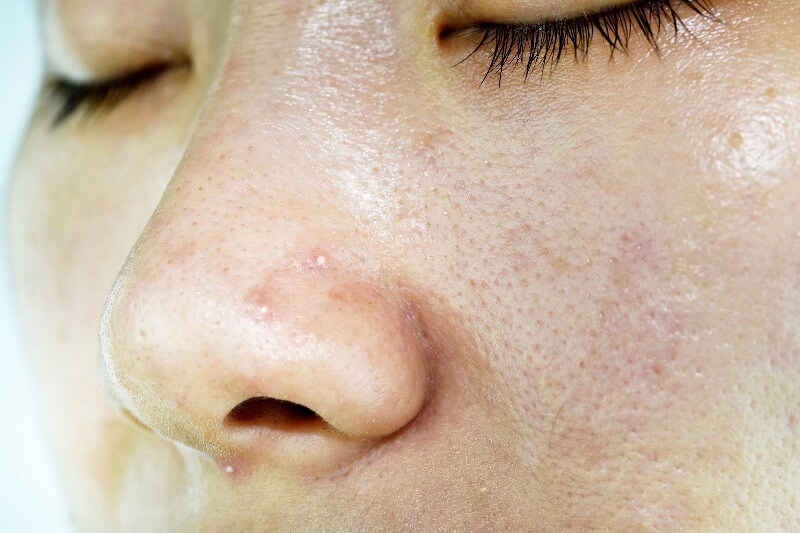
How to treat whiteheads?
Whiteheads may be slightly more difficult to treat with OTC medications than blackheads because the pore’s top is closed.
Try skincare products (cleansers, toners, lotions) with salicylic acid to unclog the pores, or spot acne treatment products with benzoyl peroxide. If those do not work, use topical retinoids prescribed by your doctor.
Facial treatments are essential for keeping blackheads and whiteheads in check. Vibrant Skin Bar offers a scope of facials that can remove blemishes, prevent breakouts, and rejuvenate your skin.
Inflammatory Acne
Inflammatory acne form when the dirt, sebum, and dead skin cells that clog the pores mix up with bacteria. The skin becomes inflamed, breaking out in red, swollen pimples.
In some cases, bacteria may cause an infection that manifests as painful, sore acne that are hard to eliminate. This type of acne is more severe and usually requires medical assistance. Your doctor may prescribe an oral or topical antibiotic to combat persistent inflammatory acne.
1. Papules
Papules are non-contagious, red, swollen, cone-shaped bumps on the skin. They differ in size and shape but are usually smaller than 5 millimeters. They are not filled with pus but can be tender to the touch.
They form when skin-residing bacteria, Propionibacterium acnes, enter a clogged pore, break the walls of the comedo, and cause inflammation of the surrounding area. The resulting red, swollen bump is an acne papule.
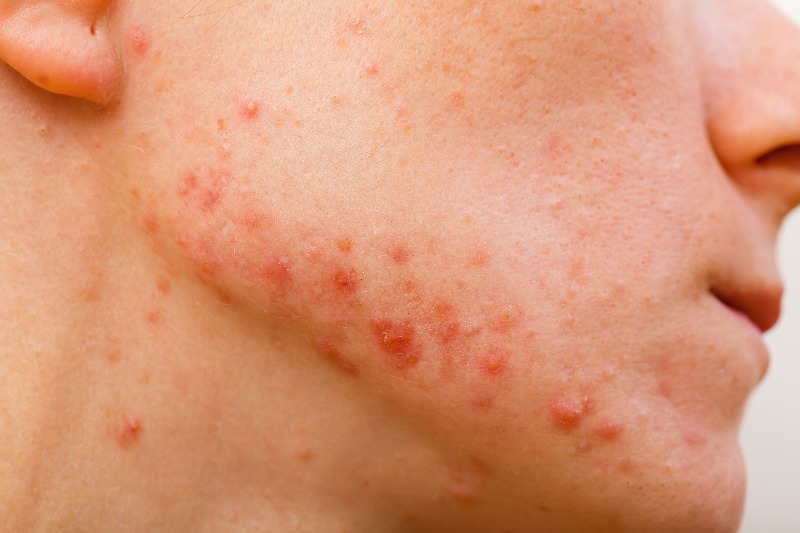
How to treat papules?
Papules sometimes respond to mild OTC treatments with salicylic acid, azelaic acid, or benzoyl peroxide. Doctors may also prescribe topical medications such as dapsone, retinoids, or antibiotics. More severe papules are treated with oral antibiotics or contraceptive drugs (for women).
2. Pustules
A pustule is a skin bump with white or yellow pus in the middle. It is either swollen and red or firm and white. The skin around the pustule is usually inflamed.
When white blood cells try to fight the bacteria in a papule, white or yellow pus forms on the pore’s surface, creating an acne pustule.
Pustules appear alone or in groups of more pustules and papules.
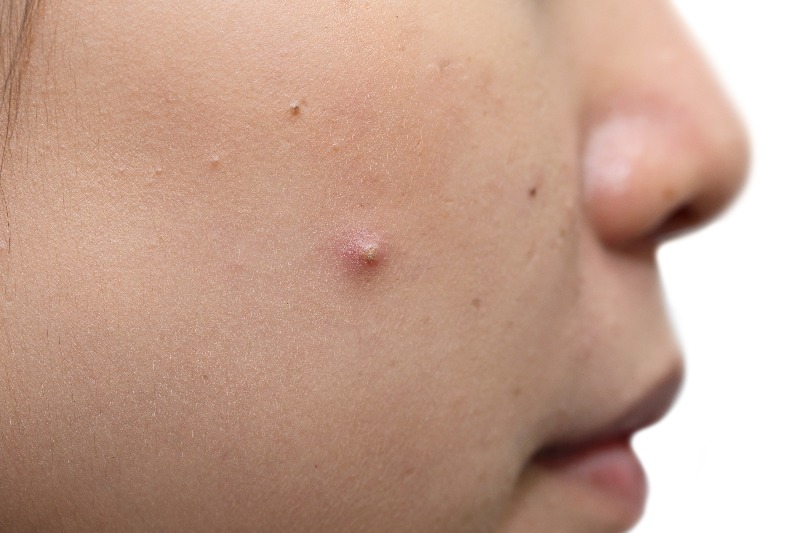
How to treat pustules?
Depending on the severity of the condition, pustules are treated with OTC products or prescription drugs. When OTC products and topical retinoids don’t work, a doctor prescribes topical or oral antibiotics. They are often used with topical benzoyl peroxide to prevent antibiotic resistance.
Do not pop pustules because the pus may spread the infection further and cause more acne.
3. Nodules
Nodules are red or flesh-colored lumps underneath the skin that are often painful, hard, and inflamed. Nodular acne are bigger and more severe than comedones, papules, and pustules. They develop deeper underneath the skin and may leave permanent scars.
When dead skin cells, sebum, and bacteria mix and clog a pore, the infection causes the pore’s walls to break. Nodular acne forms if the infection reaches the skin’s deepest layers.
Hormones and genetics are the primary causes of acne nodules. Chronic stress and certain medications (e.g., corticosteroids) can worsen the condition.
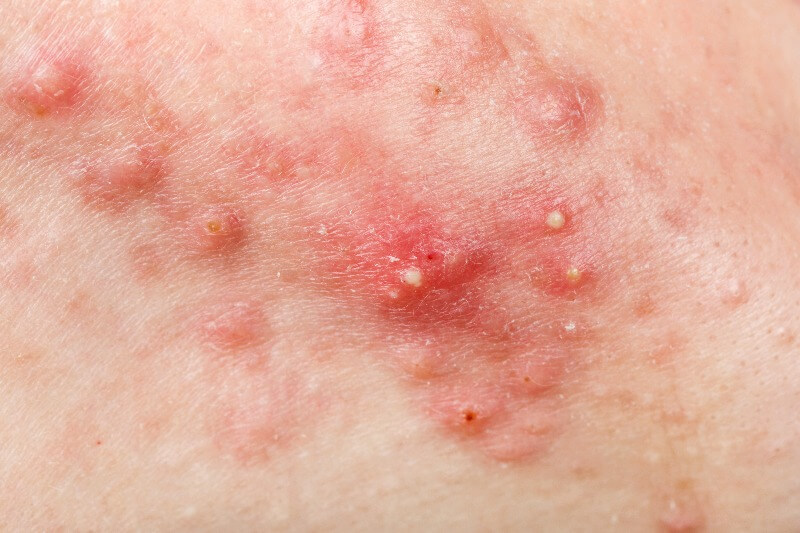
How to treat nodules?
Nodular acne requires a visit to a dermatologist and intensive treatment. The doctor may prescribe topical retinoids, oral antibiotics with topical benzoyl peroxide, or isotretinoin, a powerful oral retinoid for severe acne. Women with nodular acne may be prescribed birth control pills.
4. Cysts
Acne cysts are red or white painful pus-filled lumps underneath the skin. These acne result from a severe infection and are the most likely to leave scars.
Like other inflammatory acne, cysts form when sebum, dead skin cells, and bacteria mix and clog a pore. When the pore breaks, the infection spreads deep into the skin resulting in an acne cyst. The cyst is filled with pus, unlike nodular acne.
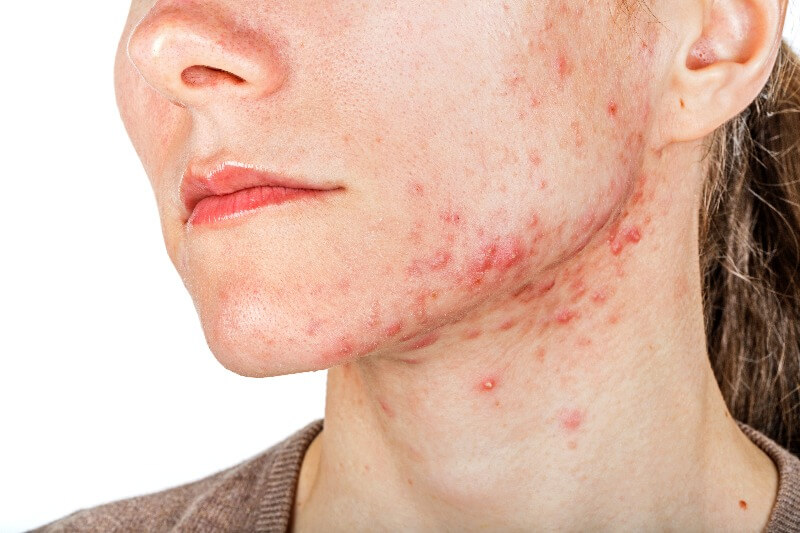
How to treat cystic acne?
Cysts require intensive treatment prescribed by a dermatologist. The treatment may include topical retinoids, oral antibiotics, oral retinoids, or birth control pills. In more severe cases, the treatment may require corticosteroid injections or surgical removal.
5. Acne Conglobata
Acne conglobata (AC) is a rare and severe form of nodulocystic acne that may develop on the face, back, chest, shoulders, thighs, and buttocks.
It forms when nodules, abscesses (pus-filled pockets), and cysts start connecting underneath the skin. These inflamed lumps can grow larger and spread deeper within your skin. They create disfiguring lesions and can turn into cysts with smelly pus.
How to treat acne conglobata?
AC requires aggressive treatment due to the degree of inflammation and potentially permanent scarring. They are not treatable with over-the-counter medication or topicals and require prompt medical help. Some doctors may run a biopsy test to rule out other skin conditions, such as carcinoma.
6. Acne Fulminans
Acne fulminans or acne maligna is a rare skin disorder that typically affects adolescent males. It develops abruptly and may be accompanied by an appetite loss, fluctuating fever, and painful joints.
It is a more severe case of acne conglobata and appears as painful, ulcerated nodular acne. It can develop bleeding crusts and cause severe scarring.
Acne fulminans is associated with increased androgens (male hormones), hypersensitivity to surface bacteria (Cutibacteria acnes), and genetic predisposition.
How to treat acne fulminans?
This clinical type of acne requires urgent medical assistance. Treatment may include corticosteroids, anti-inflammatory drugs (aspirin), dapsone, and ciclosporine, or oral antibiotics. Managing acne fulminans typically requires multiple treatment approaches that are prescribed for several months or longer.
7. Acne Mechanica
Acne mechanica develops due to rubbing, scratching or pressure on the skin. It can form on its own or grow out of pre-existing acne.
Acne mechanica is most likely to appear on body parts frequently exposed to friction, such as the face, neck, arms, legs, torso, and buttocks. The most common causes include clothes, sports gear, and accessories.
How to treat mechanical acne?
Wear comfortable, breathable clothing and choose gentle cosmetics to lessen skin irritation. Depending on the acne type and severity, you can include topical solutions with benzoyl peroxide, salicylic acid, and retinoids. Consult your dermatologist for optional antibiotic creams or acne medications.
Note: Products for sensitive skin can soothe compromised skin and alleviate some of the symptoms of irritation.
8. Hormonal Acne
Hormonal acne develop due to changes in hormonal status during puberty, menstruation, pregnancy, and menopause. This condition can affect men and women of all ages.
The skin flares up due to a hormonal imbalance that overstimulates sebaceous (oil) glands and clogs the pores. This usually happens when there is an increase in testosterone, and a decline in progesterone and estrogen.
Note: Learn what is a low estrogen level, what are the 14 common low estrogen symptoms and how to increase estrogen.
How to treat hormonal acne?
Over-the-counter topical treatments with azelaic acid, niacinamide, retinol, and benzoyl peroxide can alleviate mild to moderate hormonal breakouts. Your doctor may prescribe anti-androgen medication, antibiotics, birth control pills, or suggest a bioidentical hormone replacement therapy.
Conclusion
The effectiveness of an acne treatment depends on accurately diagnosing the acne type. Though you may recognize a type based on our description, you may not be able to evaluate its severity accurately. Moreover, it is possible to develop multiple types of acne simultaneously.
We strongly encourage you to consult your doctor before booking an acne treatment. If you have more questions, our skin experts at Vibrant Skin Bar will be happy to assist you.

